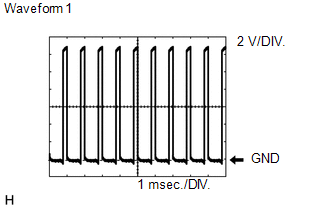Toyota Venza: Terminals Of Ecu
TERMINALS OF ECU
1. CHECK AWD CONTROL ECU

(a) Measure the voltage and resistance of the connector.
|
Terminal No. (Symbol) |
Terminal Description |
Condition |
Specified Condition |
|---|---|---|---|
|
14 (CANH) - 16 (CANL) |
CAN communication |
Ignition switch off |
54 to 69 Ω |
|
23 (GND) - Body ground |
Ground |
Always |
Below 1 Ω |
|
11 (IG1) - 23 (GND) |
Power source voltage |
Ignition switch ON |
10 to 14 V |
|
13 (SLC+) - 32 (SLC-) |
Electromagnetic solenoid signal |
D position, Idling |
Pulse generation (See waveform 1) |
|
9 (BSLC) - 23 (GND) |
Power source voltage |
Always |
10 to 14 V |
If the result is not as specified, the AWD control ECU may have a malfunction.
(b) Using an oscilloscope, check the waveform 1.
 Waveform 1 (Reference)
Waveform 1 (Reference)
|
Terminal Name |
Content |
|---|---|
|
Tester Range |
2 V/DIV., 1 msec./DIV. |
|
Condition |
D position, Idling |
 Test Mode Procedure
Test Mode Procedure
TEST MODE PROCEDURE
1. DESCRIPTION
HINT:
When using a chassis dynamometer, brake tester, etc. to perform a vehicle test,
activate test mode to avoid a "different tire diameter installed" ...
 Diagnosis System
Diagnosis System
DIAGNOSIS SYSTEM
1. DESCRIPTION
Active torque control 4WD system data can be read in the Data Link Connector
3 (DLC3) of the vehicle. When the system seems to be malfunctioning, use the Techstream ...
Other materials about Toyota Venza:
Hitch
Trailer hitch assemblies have different weight capacities. Toyota recommends
the use of Toyota hitch/bracket for your vehicle. For details, contact your Toyota
dealer.
• If you wish to install a trailer hitch, contact your Toyota dealer.
• Use only a ...
A/F Sensor Slow Response - Rich to Lean Bank 1 Sensor 1 (P014C,P014D,P015A,P015B)
DESCRIPTION
HINT:
Refer to DTC P2195 (See page ).
DTC No.
DTC Detection Condition
Trouble Area
P014C
The "Rich to Lean response rate deterioration level*" value is standard
or less ...
Driver Side Power Window does not Operate with Power Window Master Switch
DESCRIPTION
When the engine is running or the ignition switch is ON, the power window regulator
motor assembly (for driver side) is operated by the power window regulator master
switch assembly. The power window regulator motor assembly (for driver side) ...
0.1283
